Diaghilev’s Ballets Russes, 1909-1929. When Art dances with music. Exhibition at CaixaForum Barcelona, 5 October 2011 - 15 January 2012, and at CaixaForum Madrid, from 16 February 2012
SERGE DIAGHILEV (Novgorod, 1872 - 1929, Venice) is a key figure to understand the evolution of dance in the 20th century. Through his company, the Ballets Russes, he championed the idea of a total work of art and aimed at a renovation in visual language, both in his choreography and stage design, musical language and costumes. He acted as a catalyst for the European cultural world at the beginning of the 20th century and left a rich legacy of music, dance and art that reverberated throughout the rest of the century. The dramatic performances of Serge Diaghilev transformed dance, arousing a renewed interest in ballet throughout Europe and America.
Serge Diaghilev was a cultured man, a keen reader and collector of books, with an amateur’s passion for music and song, and was fond of the theatre and painting. From a very young age he was in contact with artists, he travelled through Europe and alternated between his facet of critic and writer and that of publisher and organiser of exhibitions. Diaghilev’s cosmopolitan background and enterprising spirit were decisive factors when he launched the Ballets Russes project in 1909.
In the early years of the 20th century, an artistic and musical avant-garde appeared in Russia that was not very well-known internationally. Serge Diaghilev came up with the idea of creating a group of outstanding dancers from the Ballet Imperial of the Maryinsky Theatre in Saint Petersburg and presented them in Paris in a high category show that included music, dance, painting and literature: a total work of art that showed the world the vitality of modern Russia.
For twenty years, the Ballets Russes presented about fifty ballets of different styles in Europe and America in which the top European dancers performed, with music scores written by the most outstanding composers and with the collaboration of the most well-known artists of the time. Diaghilev contacted artists from different fields for montages that have remained for posterity, such as Le Tricorne by Manuel de Falla or Parade by Eric Satie with the stage design by Picasso.
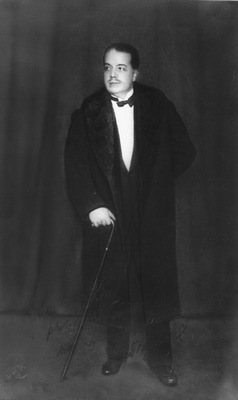 SERGE DIAGHILEV
SERGE DIAGHILEV
© V&A Images
His success was due to his aim for renovation of visual language, both in the choreography and stage designs, and in the musical language. The essential factor was using dance through the human body to express stories and feelings and, based on this, developing the talent of his dancers.
Avant-garde visual artists of the stature of Matisse, Picasso, Braque, Derain, Goncharova, Laurencien or Chanel took part in designing the costumes and stage designs; renovating musicians, such as Ravel, Satie, Falla, Stravinsky, Prokofiev, Rimski-Korsakov; dancers, such as Fokine, Nijinsky, Pavlova, Karsavina or Massine, and writers, such as Jean Cocteau worked together, encouraged by Serge Diaghilev.
This exhibition has been organised by the Victoria & Albert Museum in London – where it could be viewed last year and more recently at the National Museum of Fine Arts in Quebec – and produced by the "la Caixa" Foundation, with a review of the figure of Serge Diaghilev and passing through the most important scenarios and events in which his company performed during the twenty years it existed.
Therefore, Diaghilev’s Ballets Russes, 1909-1929. When Art dances with Music conveys a spirit that permeated the company through the exceptional collection of the Victoria & Albert Museum, which preserves a large part of the Ballets Russes’ costumes – many of which were acquired at auctions held by Sotheby’s between 1967 and 1973 –, the scenery for six of Diaghilev’s ballets and large collections of designs, drawings, prints, different objects and archives. It is a remarkably rich legacy, recreating the atmosphere of a period of great artistic vitality between 1909 and 1929.
Although some of the dancers performed in films, Serge Diaghilev categorically prohibited any filming of Ballets Russes and included clauses in the contracts signed that imposed this prohibition. Diaghilev thought that films, due to being in black and white and silent at the time, could not capture the colourful and collaborative magic of his productions. However, the exhibition that will be held now at the CaixaForum Barcelona will show for the first time a sequence secretly filmed and only recently discovered, with 60 seconds of the Ballets Serge Lifar with Diaghilev to his right, Boris Kochno on his left, and company members.
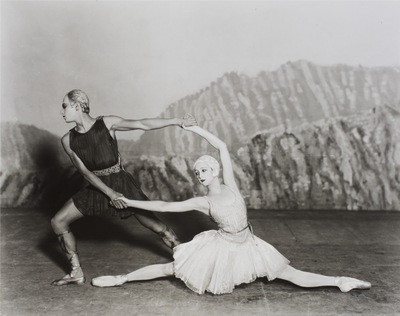 Serge Lifar and Alexandra Danilova in Apollon Musagète, 1928
Serge Lifar and Alexandra Danilova in Apollon Musagète, 1928
showing the first version of the costumes designed by Coco Chanel.
Photograph by Sasha © V&A Images
The extraordinary display created for this occasion takes visitors behind the scenes of the Ballets Russes’ productions: its inspiration, choreography, music and stage designs. Pablo Picasso became an integral member of the Ballets Russes during the I World War. A reproduction of the enormous canvas by Alexander Shervashidze for Le Train Bleu, after a design by the painter, and a costume that was designed for Parade are on display in the exhibition.
The exhibition also explains how Ballets Russes survived the Great War, being cut off from its roots in Russia and with little access to the cities where they had performed before 1914, and ends by explaining the decade of the 1920s – a period when Serge Diaghilev had already achieved an important place in European culture. It includes a wide selection of costumes of all kinds: exotic –created by Léon Bakst for The Sleeping Beauty and Henri Matisse for Le Chant du rossignol–, extravagant –by Mikhail Larionov for Chout and Giorgio de Chirico Le Bal or elegant –the bathing suits designed by Coco Chanel for Le Train Bleu and the costume of Georges Braque for Zephyr and Flore and Marie Laurencin for Les Biches.
The Ballets Russes and Spain
By holding this exhibition, ”la Caixa” Welfare Projects fulfil its goal of informing the general public about the pioneers of art at the beginning of the 20th century and the artistic vitality at that time, which is key to understanding everything that happened in later decades. In this respect, the exhibitions devoted to Alphonse Mucha, Gustav Klimt or Maurice de Vlaminck should also be recalled.
Similarly, another aim of the exhibitions held by "la Caixa" also to create points of contact between artists, movements and historic periods of universal art in Spain. With this goal in mind, exhibitions have been organised, such as August Rodin and his relationship with Spain or, more recently, Eugène Delacroix, which pays special attention to the travels of these artists in the Peninsula.
A very important part of the history of Ballets Russes took place in cities such as Barcelona, Madrid or Sant Sebastian, where they had a remarkably warm welcome and found refuge during the years of the First World War. Spain played an important role in the survival and development of Ballets Russes. The establishment of collaboration with Spanish creators meant that Spain would be present in the highest international artistic context of the first quarter of the century.
Between 1916 and 1918, when the doors of a large part of Europe were closed for Ballets Russes, Spain was a stimulating haven for the dancers and for all the artistic collaborators. Once peace was restored, the relationship with Spain continued with the support of King Alfonso XIII, a great admirer of the company. In the twenties, after Ballets Russes had spent long periods in Monte Carlo, Barcelona became the first place the company would use as a base for its spring tours.
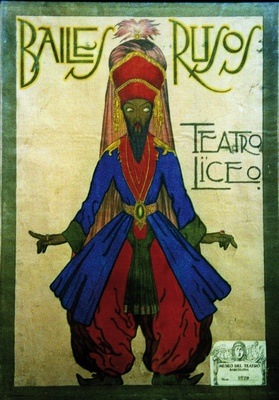 Poster for Petrushka at the Gran Teatre del Liceu, 1917
Poster for Petrushka at the Gran Teatre del Liceu, 1917
Courtesy of the MAE, The Stage Arts Museum, Barcelona
Therefore, for its exhibition at CaixaForum Barcelona and CaixaForum Madrid, the institution has prepared a new section that provides testimony of the relationship of Ballets Russes with Spain and its impact and the collaboration with Spanish musicians and artists, such as Manuel de Falla, Isaac Albéniz, Juan Gris, Joan Miró, Pere Pruna, Josep M. Sert or Joaquín Turina.
This section includes numerous objects documenting the company’s presence in Spain, such as posters, programmes, invoices, correspondence, etc. Similarly, "la Caixa" Welfare Projects has produced an audiovisual explaining the history of Ballets Russes from the time of its arrival in Cadiz, where they were met by Falla.
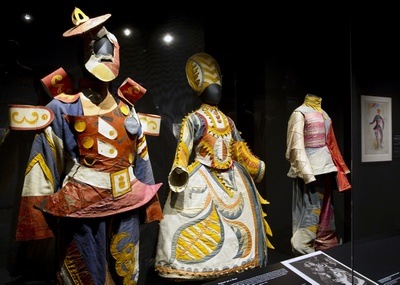

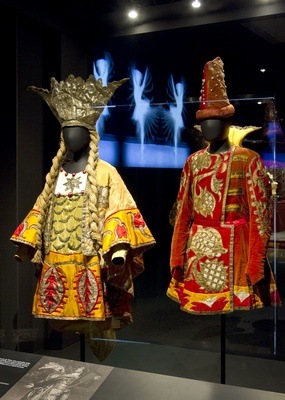
Exhibition Diaghilev’s Ballets Russes CaixaForum Barcelona
Photographs Courtesy CaixaForum Barcelona
The exhibition has been organised by Geoffrey Marsh and Jane Pritchard, museum director and curator of the Theatre and Dance Department of the Victoria & Albert Museum (V&A) respectively and can be viewed at CaixaForum Barcelona (Av. de Francesc Ferrer i Guàrdia, 6-8) from 5 October 2011 to 15 January 2012 and at CaixaForum Madrid from February 2012.
The catalogue that has been published for the occasion also includes a chapter written by the specialist Ester Vendrell in which this long-lasting relationship is explained in greater depth.
CaixaForum Barcelona
Obra Social “la Caixa” - Caixa Foundation
www.obrasocial.lacaixa.es


 TOKUJIN YOSHIOKA
TOKUJIN YOSHIOKA  An exhibition catalogue is published on the occasion of Japanese designer Tokujin Yoshioka’s inaugural Australian exhibition at Sherman Contemporary Art Foundation. Authors: Gene Sherman, AM, Chair and Executive Director of SCAF - Dolla S. Merrillees, General Manager, Artistic & Educational Programmes, SCAF - Mami Kataoka, Chief curator, Mori Art Museum, Tokyo, and International Associate Curator, Hayward Gallery, London. Published by Sherman Contemporary Art Foundation, 2011, 96 pages, 220 x 155 mm, full colour, hardback with dust jacket.
An exhibition catalogue is published on the occasion of Japanese designer Tokujin Yoshioka’s inaugural Australian exhibition at Sherman Contemporary Art Foundation. Authors: Gene Sherman, AM, Chair and Executive Director of SCAF - Dolla S. Merrillees, General Manager, Artistic & Educational Programmes, SCAF - Mami Kataoka, Chief curator, Mori Art Museum, Tokyo, and International Associate Curator, Hayward Gallery, London. Published by Sherman Contemporary Art Foundation, 2011, 96 pages, 220 x 155 mm, full colour, hardback with dust jacket. 
 Young Fashion Photographers Now 2012, Lodz, Poland, 27 - 30 October 2011
Young Fashion Photographers Now 2012, Lodz, Poland, 27 - 30 October 2011 Photo by AGATA KACPRZAK. Courtesy and © the artist
Photo by AGATA KACPRZAK. Courtesy and © the artist  Photo by ANTONINA DOLANI. Courtesy and © the artist
Photo by ANTONINA DOLANI. Courtesy and © the artist  Photo by EWA DANOWSKA. Courtesy and © the artist
Photo by EWA DANOWSKA. Courtesy and © the artist
 Photo by KRZYSZTOF ADAMEK. Courtesy and © the artist
Photo by KRZYSZTOF ADAMEK. Courtesy and © the artist Photo by LUKASZ WIERZBOWSKI. Courtesy and © the artist
Photo by LUKASZ WIERZBOWSKI. Courtesy and © the artist



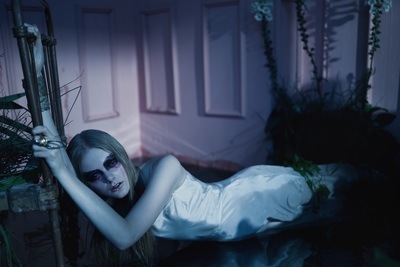 Photo by ZIJA & PIORO. Courtesy and © the artists.
Photo by ZIJA & PIORO. Courtesy and © the artists. Clément Bagot
Clément Bagot
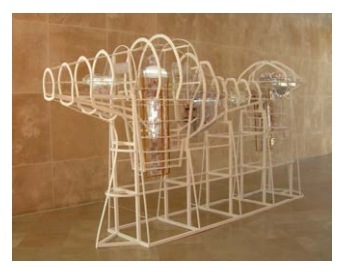


 SERGE DIAGHILEV
SERGE DIAGHILEV  Serge Lifar and Alexandra Danilova in Apollon Musagète, 1928
Serge Lifar and Alexandra Danilova in Apollon Musagète, 1928 Poster for Petrushka at the Gran Teatre del Liceu, 1917
Poster for Petrushka at the Gran Teatre del Liceu, 1917


 PATRICIA DAUDER
PATRICIA DAUDER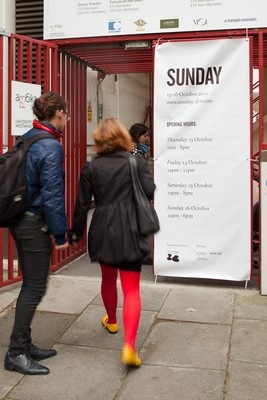










 DAVID BLANDY
DAVID BLANDY